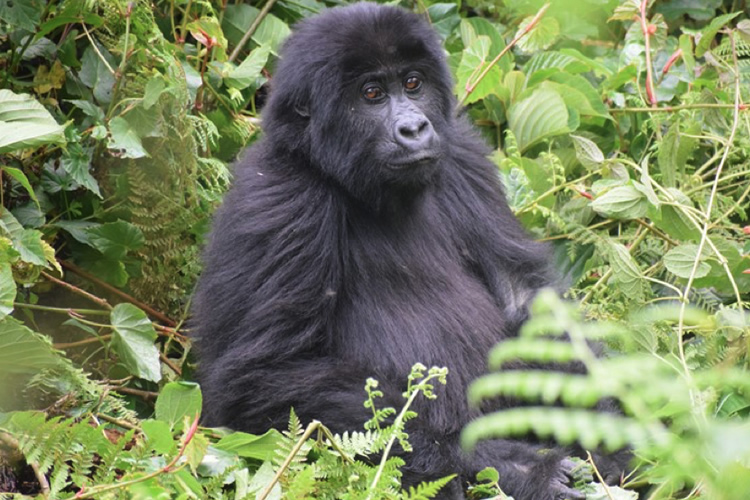Gorilla Habituation Experience in Uganda
Gorilla Habituation Experience is an exercise aimed at familiarizing humans with gorillas. The process concentrates on quenching the aggressive nature of gorillas for tourists who wish for an encounter. Gorillas are not ready for trekking until they’re fully habituated; this enables a close-up encounter with tourists without any harm from these giants.
The habituation exercise included primatologists, zoologists, and researchers, together with park rangers. These groups of experts always bump into the thick, misty afro tropical forests and launch a follow-up activity for a newly discovered or splintered wild gorilla family. The follow-up exercise continued for a period of not more than 2 years until these experts realized that the gorillas were ready for trekking.
When tracking gorillas, trekkers have to go closer to the apes within the limits of 7m. This is a shorter distance in case a silverback charges to attack, but because human presence is sometimes common to them, they may cause no harm to their charges.

gorilla habituation in Bwindi
Why gorilla habituation
Mountain gorillas are giant apes that can weigh between 120 kg for an adult female and about 200kg for a silverback, and they may have a height of about 6 feet standing upright. The gorillas possess almost all human characteristics, as they are claimed to have a DNA similarity to humans of about 9%. The apes have a lot of human imitations, among which are taking care, emotions, and the way they do all their activities.
All these features position gorillas as dangerous animals when they activate their aggressiveness. Gorillas, especially silverbacks, are very determined to defend their family members, even up to the edge of death. Their determination makes them threatening creatures to encounter in their wild homes. It makes it very necessary to initiate the habituation exercise, which helps extinguish this kind of aggressiveness.
During the habituation exercise, researchers take time to study each and every individual in the family. This activity enables rangers to know how each and every family can be approached during trekking. So, you should not trek with fear; all the power points are known by rangers, and there are set trekking etiquette guidelines for each and every family. At the moment of trekking, gorillas are free; actually, they are expecting your visitation. Remember, gorilla trekking is a way of tracing human evolution, which is believed to have happened about 7 million years ago, so just feel at home.
Gorilla habituation experience
Gorillas are residents of two major forests, which are extensions of the central African forests aligned within the arrays of the Albertine Rift. These are Virunga Conservation Areas (VCAs). The VCA is further splintered into three parks: Virunga National Park (DR Congo), Volcanoes National Park (Rwanda), and Mgahinga Gorilla National Park (Uganda). And the other destination is Bwindi Impenetrable National Park, which is home to half of the world’s mountain gorillas in the wild.
Unfortunately, all these endemic gorilla homes are open for gorilla habituation. Habitation exercise is open at Bwindi Impenetrable National Park, which gives guests the feeling of staying all day with the gorillas.
Gorilla habituation exercise starts earlier, at 6 a.m. With your full day’s pack, join the team of researchers doing habituation.
Habituation experiences are only available at Rushaga Sector, south of Bwindi Impenetrable National Park. Guests join a team of rangers, grouped with a limited number of only four trekkers, to do a habituation experience. Then, early at 6 a.m., join the team of researchers and start searching for where the gorilla family under habituation had their night. Finding this family under habituation means you have a full day of following the gorillas.
The gorilla follow-up is aimed at studying the behaviors of such a family and all the characteristics of each individual in the group.
For trekkers who feel they can’t complete a full day following the gorillas, they can spend about 4 hours with the gorillas and then return to their starting points or lodge and rest. When going for gorilla habituation, it’s advisable to go with the all-day pack.
Gorilla habituation is an unbeatable and comparable adventure in the wild. It’s not for the faint-hearted, as it involves trekking through the volcanic tropics, bamboos, valley slopes, and hill hiking until the exercise is done. Remember, you keep following the movements of gorillas, and in a day, gorillas can wander for about 3 kilometers from where they spent their previous night.

Gorilla habituation experience
The cost of a gorilla habituation permit
Gorilla habitation is limited to only the Rushaga sector of Bwindi Impenetrable National Park. The adventure is highly priced; to trek, one must have a habituation permit. The permit costs $1,500 per day. There is only one gorilla family under habituation at Bwindi, and this means only a limited number of four permits are issued to trek gorillas on a given day.
